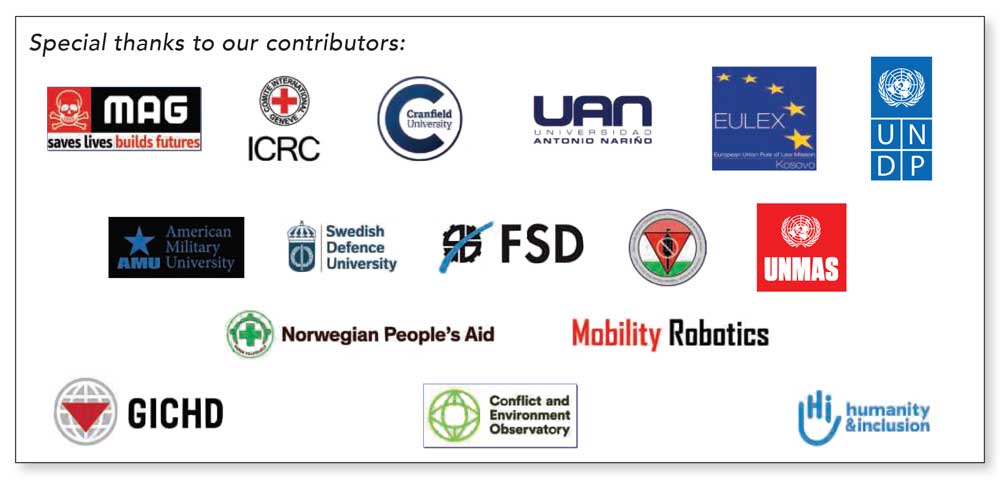A note from the interim director
Suzanne Fiederlein, PhD
CISR JournalThis article is brought to you by the Center for International Stabilization and Recovery (CISR) from issue 25.3 of The Journal of Conventional Weapons Destruction available on the JMU Scholarly Commons and Issuu.com.
As I write this, it has been two and a half months since the war in Ukraine first began on February 24, 2022, and in the wake of the global pandemic, our community is once again pivoting to adapt our planning and operations to reflect the changing global landscape. In this issue of The Journal, we feature a timely editorial from Greg Crowther, Director of Programs at MAG (Mines Advisory Group). Crowther notes that the legacy of explosive hazards is not only a future challenge for the mine action community but a present one, with unexploded ordnance (UXO), landmines, and cluster munitions threatening civilian lives and hampering humanitarian aid from reaching those who need it most. In response to the war in Ukraine, Crowther warns of the risks of an isolated approach to delivering mine action in the country, calling for a coordinated response with co-ownership involving donors, NGOs, national actors, UN agencies, and other humanitarian organizations. As noted by Crowther,
“the lesson from Iraq and from other major conflicts in places like Syria, Myanmar, and South Sudan must be learned in Ukraine: the international donor community, working in partnership, has to put in place the right mechanisms for an effective mine action response.”
A grave issue that will unfortunately be an ongoing challenge in Ukraine is the identification of human remains, often found in areas contaminated with landmines and explosive remnants of war. In this issue, we feature three articles on the convergence of forensic humanitarian action (FHA) and humanitarian mine action (HMA). In their article, “Recovery of Human Remains in Weapons-Contaminated Settings” Lou Maresca, Chris Poole, and Dr. Jane Taylor from the International Committee of the Red Cross provide guidance to support forensic and mine action operators better understand the issues when human remains and explosive hazards are both present in an area of operation. Additionally, an article from Patrick Nowak of the American Military Institute and an article from Lauren Cobham et al., highlight differences and identify numerous ways in which FHA and HMA can work better together, especially in areas of recent conflict where explosive hazards and human remains coexist.
Additional, timely topics covered in this issue include:
Environmental Impact of MA: Bui Doan Back (Norwegian People's Aid), Kimberley McCosker (NPA), and Linsey Cottrell (Conflict and Environmental Observatory) review the impact of explosive ordnance on the environment and their results from a pilot project in Vietnam that looked at the impact of heavy metals from munitions on agricultural soils and the surrounding environment.
New EOD and IEDD Competency Standards: Roly Evans from the Geneva International Centre for Humanitarian Demining discusses the revised Test and Evaluation Protocol (T&EP) 09.30 explosive ordnance disposal competency standards and amendments to the accompanying IMAS 09.30 and the T&EP 09.31 IEDD Competency Standards, a culmination of four-years’ work to update conventional EOD competencies and to add improvised explosive device disposal competencies suitable for mine action rather than traditional security tasks.
Mental Health and HMA: Dr. Reykhan Munimova and Dr. Muhabbat Ibrohimzoda from the Tajikistan National Mine Action Center (TNMAC) highlight how TNMAC has incorporated psychosocial rehabilitation into their core victim assistance activities, with further outreach work done during the pandemic to build mine survivors’ resilience in managing trauma.
Afghanistan and Tajikistan: In his article, Markus Schindler (Swiss Foundation for Mine Action, FSD) looks in depth at Afghanistan’s and Tajikistan’s contamination and the ways in which mine action has overcome the challenges presented by rugged terrain, ongoing security concerns, and a fluctuating donor landscape.
National Clearance Capacity: In Mark Wilkinson’s (United Nations Mine Action Service, UNMAS) latest article, he reviews UNMAS’ work in Iraq and discusses how observations and analysis, when contextualized within an operational MA environment, can demonstrate benefits in clearance output as well as the efficient use of donor money.
MA and Disarmament, Demobilization, and Reintegration (DDR) Processes: In their article, Laurie Druelle (independent), Henrique Garbino (Swedish Defence University), and Eric Mellado Åhlin (independent) seek to identify areas where DDR and HMA intersect, suggesting methods for future research, implementation, and discussion around the potentially synergic relationship between HMA and DDR.
Thermal Infared Imaging: John Fardoulis (Mobility Robotics), Xavier Depreytere (Humanity & Inclusion), and Jonathon Guthrie (Norwegian People’s Aid, NPA) demonstrate that sub-surface cluster munitions in the Iraqi desert can be found using thermal infrared imaging and UAVs. They advocate for additional data collection in the field and for greater collaboration between technical experts and HMA practitioners.
As evident in the articles published in this issue of The Journal, our community is not only resilient when presented with global conflict but stronger for working collaboratively. While responding to the current threats and immediate needs of those living in conflict and recent post-conflict environments, our contributors have demonstrated the community’s diverse range of operations encompassing environmental concerns, survivor assistance, operational standards, and more. With this in mind, we at CISR relish once again meeting in person at several recent and upcoming events in Croatia, Montenegro, Munich, and Geneva. We look forward to seeing you soon.
Safe travels,

Suzanne Fiederlein, PhD


